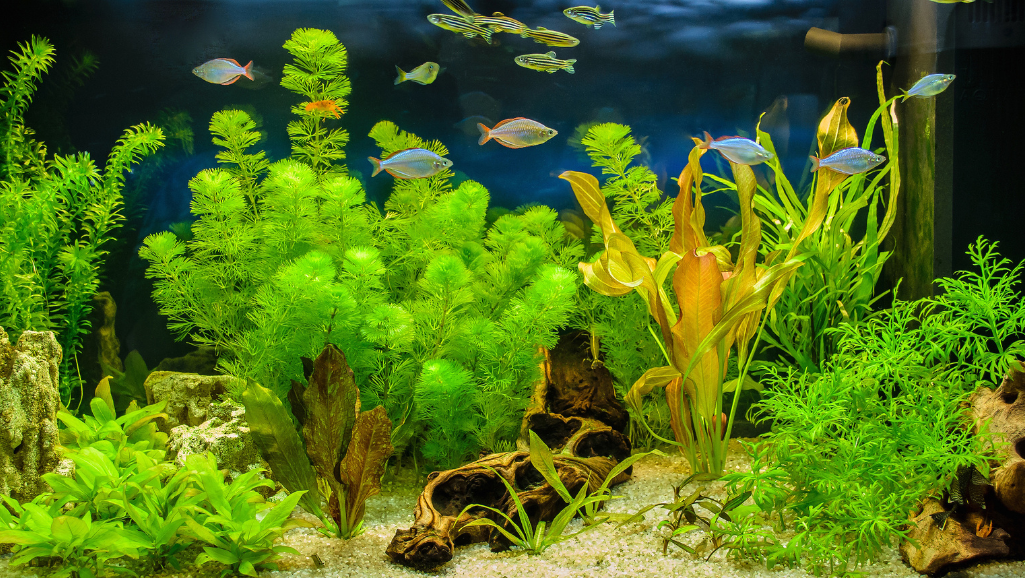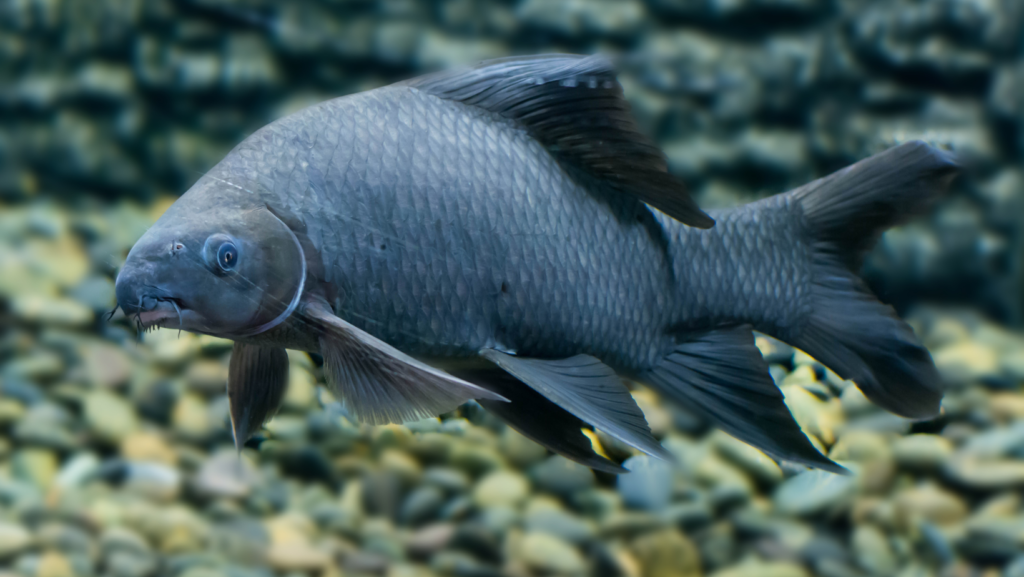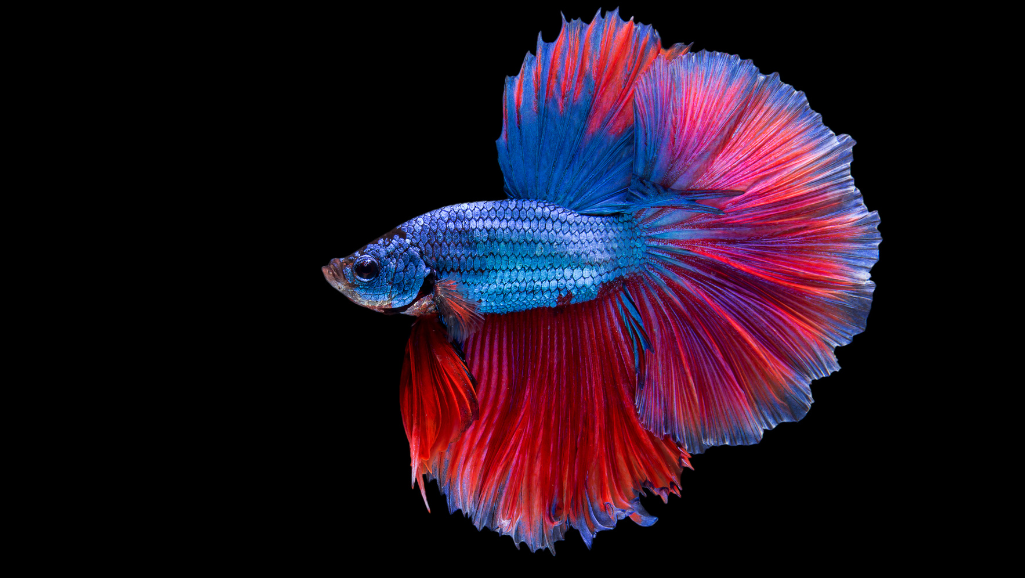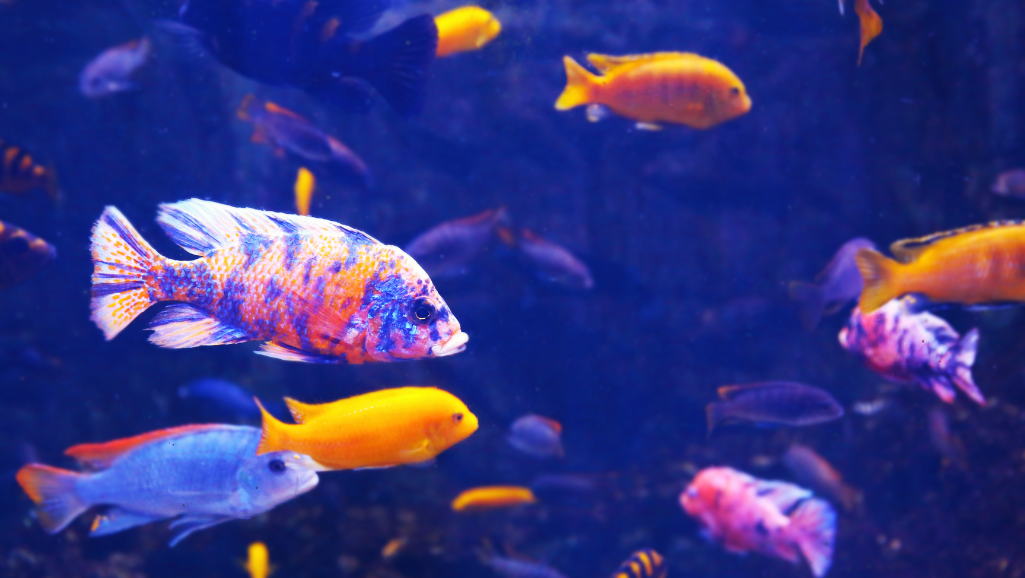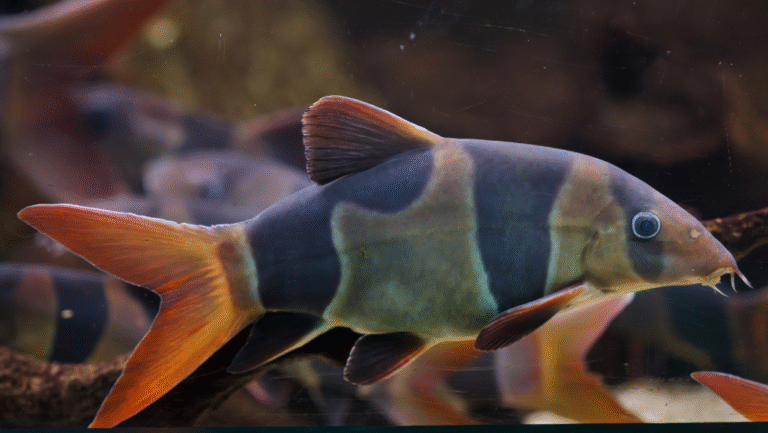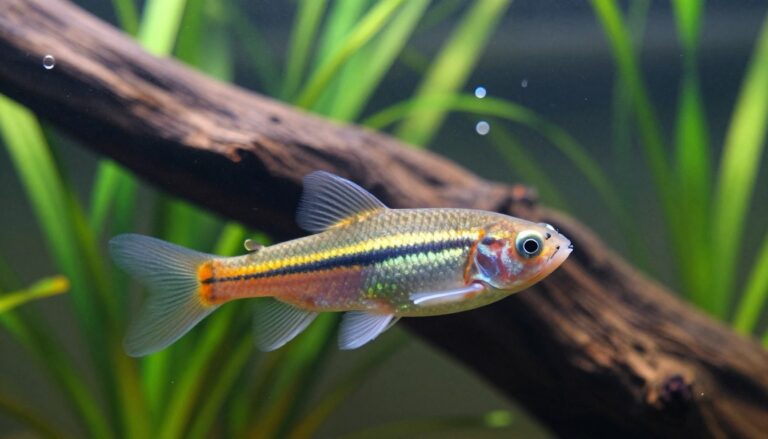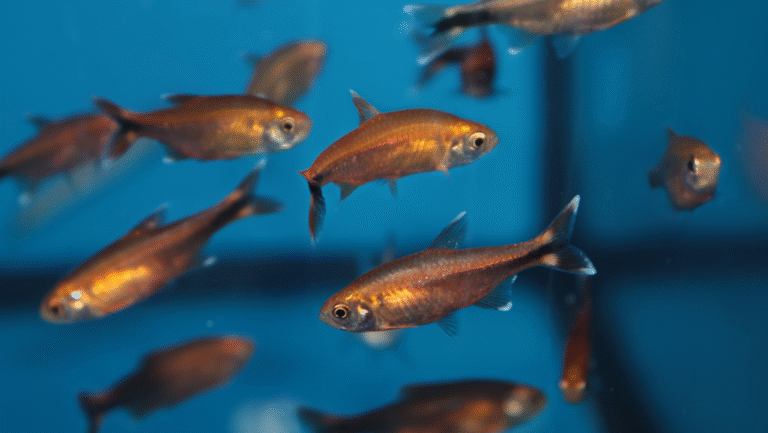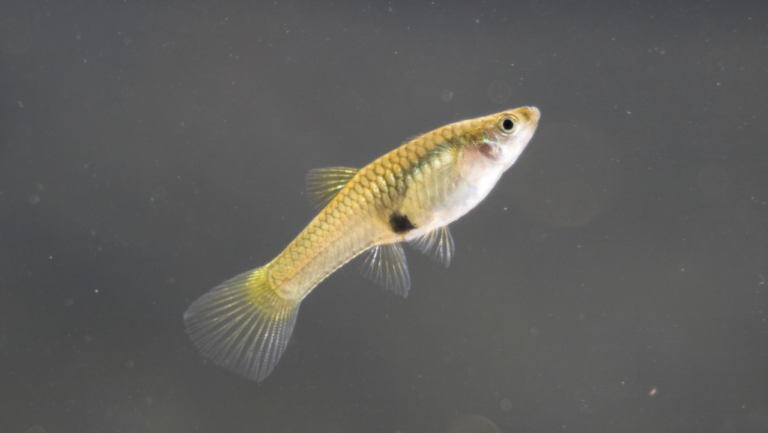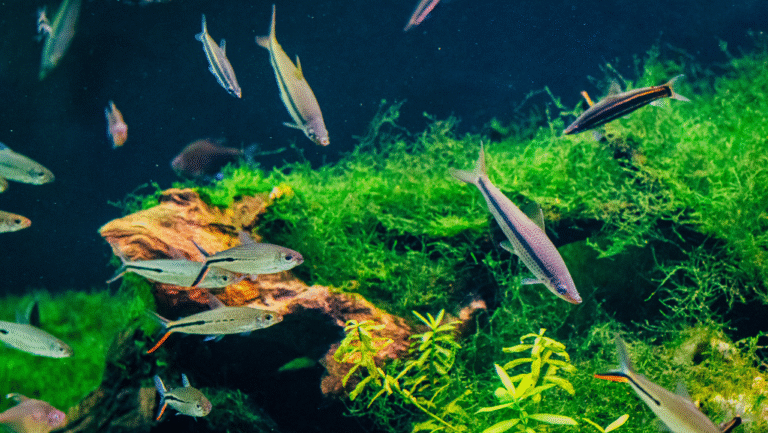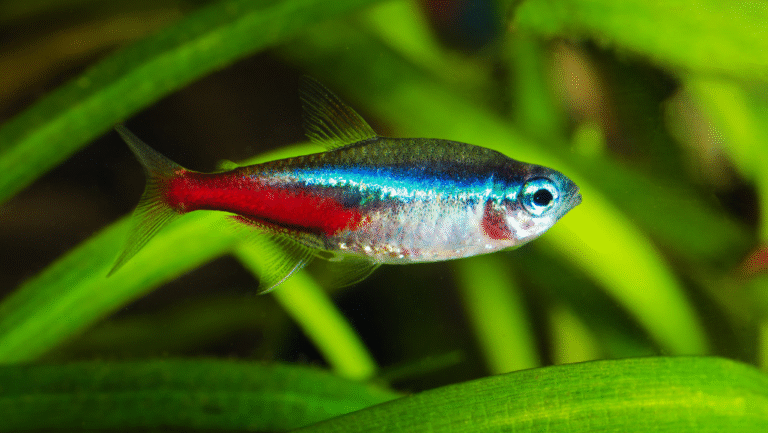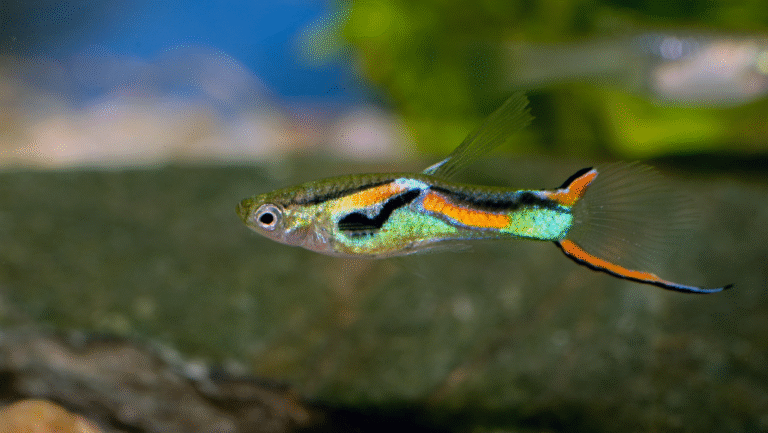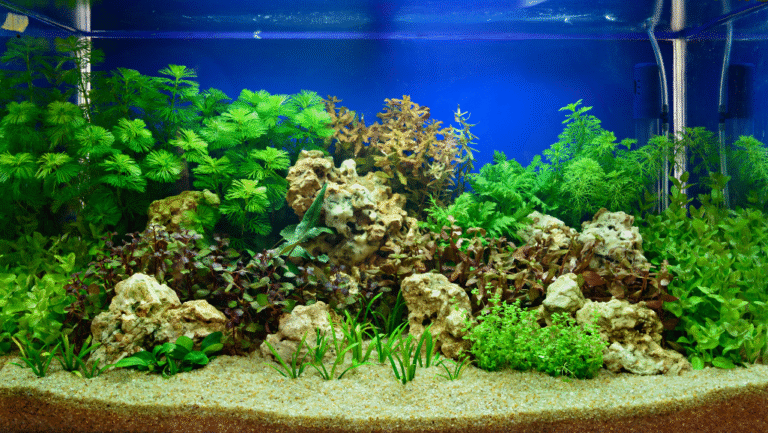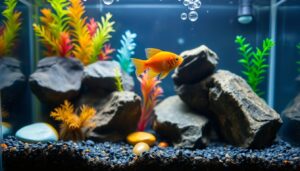The underwater world of freshwater is full of life and color. Freshwater aquarium fish are like treasures for hobbyists. They show us a world where colors and characters are endless. With over 15,000 species, there’s a wide range of sizes, colors, and personalities to choose from.
From the bright bettas to the hardworking plecos, freshwater is alive with magic. This magic is found in less than 1% of Earth’s water but is home to nearly half of all fish species. When you explore freshwater, you can find the best freshwater fish for aquariums. These fish are perfect for beginners or experienced aquarists, depending on what you’re looking for.
Some fish, like bettas, are happy in small spaces. They can live well in tanks as small as 3 gallons. On the other hand, plecostomus need a lot of room, up to 50 gallons, because they can grow quite large. Fish like corydoras catfish and Kuhli Loaches prefer smaller groups, showing that size and social needs matter too.
For those who love unique fish, cichlids are a great choice. They come in thousands of species, each with its own look and behavior. Found in Africa and South and Central America, they add excitement to any aquarium. Exploring the 10 examples of freshwater fish can be a thrilling adventure.
Key Takeaways
- Immense biodiversity within freshwater environments creates a vibrant aquarium hobby.
- Choosing the right freshwater fish hinges on tank size, compatibility, and aquarist experience.
- Bettas and tetras adapt to smaller aquariums, while others like plecostomus need larger spaces.
- Cichlids offer a kaleidoscope of options for the enthusiast, demanding specific care.
- The hobby is accessible whether one selects popular freshwater fish or ventures into the exotic.
- Colorful freshwater fish species like guppies and barbs enrich the aquarium with movement and vibrancy.
- Understanding the ecological roles and natural habitats of fish enriches the aquarium-keeping experience.
Exploring the Diversity of Freshwater Fish
Freshwater ecosystems cover a small part of our planet but are full of life. They are home to a wide variety of types of freshwater fish. These fish have special features and are key to keeping the environment balanced.
The Importance of Freshwater Ecosystems
Freshwater places are home to 41.24% of all fish species. Yet, they face big threats from humans. The number of freshwater fish species list members has dropped by 83% since 1970. This shows we must act fast to save these important places.
Freshwater Fish Classification and Their Role
Knowing how to classify freshwater fish helps us understand their role in nature. Fish of all kinds, from top predators to those that clean up the bottom, keep the water healthy. They affect everything from how nutrients move to the food chain.
Identifying different freshwater fish is crucial for protecting them. Sadly, a third of these fish are at risk of disappearing. This makes saving them even more urgent.
| Region | Number of Species | % of Endemic Species | % of Cave-Dwelling Species |
|---|---|---|---|
| Guangxi, China | 380 | 33.68% | 21.84% |
| North America | Varies | Data Unavailable | Data Unavailable |
| Yangtze Basin, China | 65 | Threatened | Data Unavailable |
In places like Guangxi, the mix of rivers and sub-basins creates a rich variety of habitats. This leads to a high number of freshwater fish that are found nowhere else. The special conditions of each area shape the fish that live there, showing how delicate these ecosystems are.
These water bodies face many dangers, like pollution and climate change. The health of their fish is more important than ever. Keeping up the research and protection of these fish is key to saving our planet’s biodiversity and health.
An Introduction to Common Freshwater Fish
Exploring the world of common freshwater fish opens up a vibrant and fascinating realm. Each species has unique characteristics and care needs. Whether you’re new to fishkeeping or experienced, knowing the most popular common types of freshwater fish can make your aquarium better.
Bettas are lively and colorful, known for their vivid hues and dynamic personalities. Barbs are community-oriented, appreciated for their striking patterns and sociable nature. Danios are great for activity and movement, thanks to their energetic swimming habits.
Tetras are easy to care for, with a wide range of colors. They’re perfect for decorative community tanks. Guppies are known for their prolific breeding and should be kept in single-sex groups to manage their population.
The aquarium hobby offers many unique species. From the gentle giants like the White Sturgeon to the challenging Steelhead fish, each species adds something special. Below, we provide a table showcasing some notable freshwater fish, helping you choose your next aquatic addition.
| Fish Species | Max Size | Lifespan and Habitat |
|---|---|---|
| Alligator Gar | Over 8 feet, 300 pounds | North American rivers |
| White Sturgeon | Up to 10 feet | Large freshwater lakes and rivers |
| Muskie | Over 50 inches | North American lakes and rivers |
| Brook Trout | Various sizes | Eastern US mountain streams |
| Buffalo Fish | Over 70 pounds | Large rivers and lakes in the USA |
| Peacock Bass | Various, | Southern Florida waters |
Understanding these common types of freshwater fish helps create a sustainable and visually appealing aquarium. From giants to tiny fish, each adds a unique splash of life and color to your aquatic ecosystem.
Bettas: Vibrant and Graceful Freshwater Companions
Bettas, also known as Siamese Fighting Fish, are famous for their bright colors and graceful fins. They are perfect for small tanks, making them a great choice for beginners. Their beauty can turn any home into a tropical paradise.
Bettas need at least 3 gallons of water to live well. This makes them a great pick for those starting with beginner freshwater fish. They are easy to care for, needing a clean tank and regular food.
Care Requirements for Bettas
Knowing betta fish care tips is key to keeping them healthy. Bettas like warm water, between 75° to 80°F (24°C to 27°C). They also prefer slightly acidic to neutral water, which is close to their natural habitat.
Tank Mates and Setting up a Comfortable Habitat
Male Bettas should live alone to avoid fights. But, female Bettas can live together in a group, called a “sorority.” A tank with lots of hiding spots, like caves or plants, helps them feel safe and happy.
| Fish Type | Minimum Tank Size | Temperature Range | Suitable for Beginners? |
|---|---|---|---|
| Bettas | 3 gallons | 75° to 80°F | Yes |
| Guppies | 10 gallons | 75° to 80°F | Yes |
| Rasboras | 5 gallons | 75° to 80°F | Yes |
| Pea Puffers | 5 gallons | 74° to 82°F | No |
With these tips, even beginners can take care of their first betta fish. They are perfect for small tanks and are easy to care for.
Barbs: The Active and Colorful Freshwater Residents
Barbs are known for their bright colors and energy. They are perfect for beginners looking for colorful freshwater fish. Cherry Barbs and Tiger Barbs are favorites because of their vibrant colors and lively nature. They make great additions to community tanks.
These fish are great for beginners because they are hardy and easy to care for. They do well in groups, making them perfect for freshwater fish for community tanks. Keeping them in groups helps prevent aggression, especially in Tiger Barbs.
- Lifespan ranges from 1 to 3 years, depending on the species.
- Size varies, with Tiger Barbs growing up to 3 inches.
- Recommended tank size starts at 30 gallons for smaller species.
- Water temperature should be kept between 75° to 82° Fahrenheit, with a pH balance ranging from 6.0 to 8.0.
- A balanced diet for Barbs would include high-quality flake food, along with periodic treats of live or frozen foods like brine shrimp and bloodworms.
- While they are generally peaceful, caution is advised when pairing them with slow-moving or long-finned fish.
By creating a diverse and balanced ecosystem, these colorful freshwater fish for beginners will enhance your tank’s beauty. They also help create a lively and vibrant aquatic community.
The Enigmatic Danios: Small but Mighty
Danios are a favorite among aquarium beginners. They are small and love to swim, adding color to any tank. They do well in tanks as small as 10 gallons, making them great for small spaces.
Danios are very tough and can handle changes in water. They are also fun to watch with their fast movements. But, they can be a bit territorial with other fish.
| Variety | Size | Minimum Tank Size | Water Conditions |
|---|---|---|---|
| Zebra Danio | Up to 2 inches | 10 gallons | Temperate; flexible |
| Celestial Pearl Danio | 1-1.5 inches | 10 gallons | Tropical; stable |
| GloFish Danio | Up to 2 inches | 10 gallons | Temperate; stable pH |
Danios are not just pets; they help scientists learn about hearts and growth. They are beautiful and help us learn new things. This makes them special in aquariums around the world.
When you get Danios, make their tank like their home. This makes them happy and active. Give them lots of space and plants to swim around in.
In short, Danios are perfect for small tanks. They are tough, beautiful, and fun to watch. They make your tank lively and healthy.
Tetras: A Rainbow of Freshwater Varieties
Tetras are a colorful and key part of any aquarium. They have shiny scales and swim together peacefully. This makes them great for beginners and adds beauty to any tank.
These small fish live well with others in community tanks. They are easy to care for and make a lively yet calm space. This is good for both new and experienced fish keepers.
Understanding Tetra Behavior and Ideal Tank Conditions
Tetras love soft, slightly acidic water and lots of hiding spots. Plants and driftwood are perfect for them. They also need dim lighting to stay comfortable and colorful.
Feeding them a mix of flake food and live foods keeps them healthy. This diet helps them stay vibrant, like other colorful freshwater fish.
Creating a Thriving Community Aquarium with Tetras
Adding different tetra species makes your tank more interesting. The Neon Tetra has a beautiful blue and red stripe. The Congo Tetra has many shimmering scales.
Keeping them in groups is not only pretty. It also lets them swim together naturally. This can be very soothing to watch.
For more on rainbowfish, check out this guide. If you’re interested in saltwater fish, this resource is a good place to start.
| Tetra Species | Recommended Tank Size | Suggested Group Size |
|---|---|---|
| Buenos Aires Tetra | 30 gallons | 8+ |
| Rummy Nose Tetra | 20 gallons | 8+ |
| Bleeding Heart Tetra | 30 gallons | =8 |
| Emperor Tetra | 30 gallons | 10+ |
| Congo Tetra | 55+ gallons | =8 |
| Black Neon Tetra | 20 gallons | 8+ |
| Diamond Tetra | 20 gallons | 8+ |
Guppies: Hardy and Prolific Breeders
Guppies are known for their bright colors and toughness. They are great for beginners because they can handle different water conditions well. Let’s look at why guppies are so easy to care for.
Guppies breed a lot and are very colorful. They do well in many water types with little care. If you’re new to fish, understanding guppies is key.
Guppies grow from 1.6 to 2.3 inches, fitting well in small tanks. Female guppies can get pregnant for 28 to 30 days and stay fertile for a while. This means you need to keep their numbers in check to avoid overcrowding.
Learn more about livebearers like guppies. They come in many colors and patterns, making your tank look great.
Guppies like temperatures between 73-75°F, but can handle up to 84°F. They do best in pH levels of 7.0 to 8.5. Keeping the water clean is important to keep them healthy.
Guppies like to be with other fish. They get along with peaceful species like Platies and Corydoras. For a small group of 10-12 guppies, a 40-liter tank is best.
Guppies are not just fun to watch; they teach you about taking care of fish. They are perfect for beginners. They show how beautiful life can be in a home aquarium.
Start learning about different fish care and species here. It’s a great way to enjoy fishkeeping.
10 Examples of Freshwater Fish
Setting up a freshwater aquarium is exciting for many. It’s a chance to see vibrant colors and meet different fish species. Some fish are especially popular because they are colorful and easy to care for at home.
Cichlids: Freshwater Royalty with Diverse Needs
Cichlids are among the most popular freshwater fish species. They come in many colors and can make any aquarium lively. But, they need special water conditions, which is why they’re best for experienced aquarists.
These fish need water that’s just right, like their natural homes. This means keeping the pH and water hardness just so. It’s perfect for those who love to create a detailed underwater world, like those who enjoy unique freshwater fish.
Gouramis: Unique Behaviors of Labyrinth Fish
Gouramis are special because they can breathe air from the water’s surface. This is thanks to a special organ called the labyrinth. It helps them survive in low-oxygen water.
These fish are not only tough but also come in many colors. You can find them in bright blues or soft silvers. This makes them a hit with aquarists who love variety and beauty.
Adding cichlids or gouramis to your tank is more than just about looks. It’s about creating a home that meets their needs. Experienced hobbyists find these fish rewarding to care for.
Watching these fish can be truly captivating. It shows the hard work and dedication needed to keep them happy and healthy. It’s a chance to see some of the most interesting behaviors in the hobby.
Highlights of Choosing Freshwater Aquarium Fish
Choosing fish for your aquarium is more than just picking the prettiest ones. It’s about understanding freshwater fish care tips and picking species that fit your experience level. This guide will help you pick the best freshwater fish for beginners and show you how to create a peaceful aquatic home.
Selecting Fish Based on Experience Level
For beginners, picking the right fish is key. The best choices for beginners are Guppies, Tetras, and Cory Catfish. They are beautiful and easy to care for, perfect for those learning about freshwater fish care tips.
Freshwater Fish Care Tips and Maintenance
Good care and maintenance are essential for a healthy aquarium. A key tip is to think about fish grouping. For example, Neon Tetras and Celestial Pearl Danios look and act best in groups, just like in nature.
| Fish Species | Group Size | Temperature Range (°F) |
|---|---|---|
| Neon Tetras | 6+ | 70-81 |
| Celestial Pearl Danios | 10+ | 73-79 |
| Rummynose Tetras | Large groups | 72-80 |
| Platies | 5-6 | 70-82 |
| Guppies | As needed (prolific breeders) | 72-82 |
Don’t forget about the tank’s environment. Make sure the water temperature and filtration are right. Also, give your fish enough room to swim and hide. Regular water changes and checking the water quality are also important for a healthy tank.
To keep your freshwater fish for home aquariums happy and healthy, start with easy species. Use these care tips from the beginning. As you get more experience, you can add more challenging species. For more tips, check out this guide on choosing the right fish size and providing enough space. With these practices, your aquarium will thrive and become a beautiful part of your home.
Conclusion
Exploring the world of freshwater fish for aquariums shows us a wide range of choices. From the calm swimming of tetras to the lively breeding of guppies, there’s a fish for everyone. Whether you prefer tropical fish or game fish, there’s a perfect match for every aquarium.
Looking at the numbers, we see the importance of freshwater ecosystems. This year alone, 243 new species were found, but 25% are at risk. This highlights the need for sustainable fishkeeping practices.
Fishkeeping is more than just a hobby; it’s about caring for our planet. In India, fish farming is a big deal, making up 7% of global fish production. Freshwater fish are not just for our aquariums; they’re vital for our planet’s health and prosperity. Let’s work together to protect and celebrate these amazing species.
